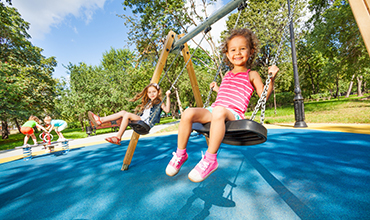As tired parents of poor sleepers and early risers, my husband and I loved a good playground. We could find a bench, settle our weary bones and watch our kids enjoy being out in the fresh air. We might even occasionally rally to push a swing, accept a make-believe mulch ice cream or cheer on a child who had climbed to the top of the play structure.
It was clear that our kids were delighted – the laughter, bursts of activity and big smiles made that readily apparent. What was less obvious, however, were the physical, social and emotional benefits they were gaining from their playground play.
HEAD TO THE PARK
Besides having tired out, happy kids, there are additional advantages that come from time spent at the playground.
Physical Perks:
– Fitness. The American Academy of Pediatrics recommends that children ages 3-5 get at least three hours of physical activity per day while children ages 6 and older need 60 minutes of moderate to vigorous physical activity on most days of the week.
– Health. Regular physical activity decreases the risk of cardiovascular disease, obesity and other chronic diseases, such as juvenile diabetes. Playground play also offers bone-strengthening activities, which are so important as childhood is a critical time for bone development.
– Sleep. Being active during the day helps children and teens fall asleep easier and promotes deeper, more restful sleep.
– Appetite and Digestion. Movement and exercise stimulate the appetite and help to promote better digestion.
– Gross Motor Development. Gross motor skills involve the whole body and playgrounds offer many opportunities to run, jump, climb and stretch.
Social and Emotional Benefits:
– Mood. Research shows a strong correlation between physical activity and a reduction in stress and anxiety. Time spent outdoors is also known to reduce stress and anxiety, making playground play the perfect two-for-one.
– Risk-Taking Behavior. Children who participate in regular playground play learn to take healthy physical risks as they challenge themselves to jump and climb in a safe environment and naturally learn which physical risks are appropriate.
Academic Performance. Being active can have a positive impact on cognitive skills and has been linked to improvements in grades and standardized testing scores.
– Concentration and Attention. Physical activity has been shown to increase a child’s ability to focus, both at school and outside of school.
– Social Skills. The playground is ripe for opportunities to practice cooperation and sharing as children take turns with the equipment. It also encourages communication practice when they set rules for games or play make-believe. Older children who use the playground for sports or other activities are also afforded opportunities to play and cooperate with children who might not be in their daily social circles.
AIM FOR VARIETY
Just like a varied diet is good for your health, if possible, aim to include several different playgrounds in your child’s playtime rotation. Visiting multiple playgrounds will help prevent boredom and will encourage continued imaginative play. In addition, the different types of playgrounds offer unique experiences and opportunities for physical and emotional development.
– Traditional. These are the playgrounds that we grew up with and are the ones most often found at schools. Consisting of formal play structures, they often have swings, slides and climbing structures. Traditional playgrounds are great for gross motor development as well as physical fitness. The limited play pieces encourage taking turns, cooperation and communication.
– Nature-Centered. These playgrounds eschew traditional play equipment for more natural structures such as logs for scrambling over, creeks for wading in and trees for climbing. With its native shrub maze, giant grapevine “birds’ nests” and tree stumps to climb on, the Lady Bird Johnson Wildflower Center’s Luci and Ian Family Garden is an example of this type of playground. Nature-centered playgrounds are excellent not only for physical fitness but for fostering imaginative play. These types of playgrounds are also wonderful for reducing stress and anxiety.
– Hybrid. As our society has become more educated about the benefits of incorporating nature into daily life, more hybrid playgrounds are becoming available. These playgrounds combine traditional playscape pieces with natural elements, providing the best of both worlds. The new downtown Austin Alliance Children’s Garden, formerly called Butler Park, is a stunning example of this type of playground. The majority of the play amenities have been integrated into the landscape, and the playground designers were intentional about incorporating as many plants, trees and grassy areas as possible. Interactive pieces allow for imaginative play. The play structures, as well as several natural elements, encourage healthy risk-taking too.
As you can see, playgrounds aren’t simply child’s play. They offer myriad benefits for your child. Now you can feel even better about finding that playground bench and sitting down to relax. You’ll actually be helping your child to learn and grow!

















